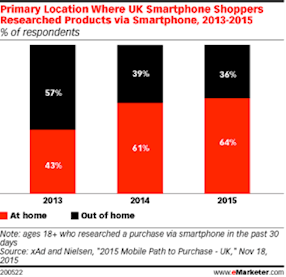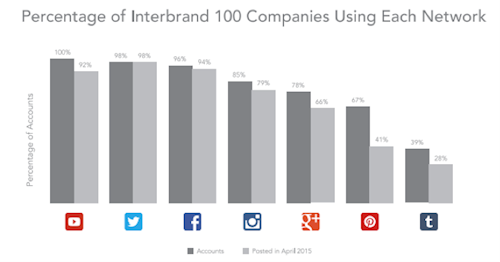2015 - Content finally becomes King...
Brands now have to focus on understanding what content consumers will consume, but also what will encourage them to share it with their peers. So, why has this finally started to become a reality? What were the key trends and developments in digital marketing in 2015?
1. Google prioritises quality content.
For most brands much of their web traffic comes from Google, so changes in the SEO algorithm have a huge impact on the success of their programmes. Over the last couple of years, these changes have meant that sites that create engaging content, update it frequently and encourage others to share and link to it, will achieve higher Google rankings, and of course, more site visitors.
2. Facebook becomes more personalised. Facebook has also updated the way it displays content in your news feed, which again prioritises engaging content. The implications for brands are pretty serious. Historically, brands attempted to get as many Facebook followers as possible, in the knowledge that they would then be able to use Facebook to talk to their fans for free via their news feeds. But that has now changed. Your news feed content is driven by your behaviour, so every time you like a post or share content with others, you are telling Facebook that you are interested in it. Facebook uses this information to personalise your news feed. So, for brands only a small percentage of your followers are likely to see your updates (some brands have said this could be as low as 15-20%).http://techcrunch.com/2014/04/03/the-filtered-feed-problem/
Facebook has also updated the way it displays content in your news feed, which again prioritises engaging content. The implications for brands are pretty serious. Historically, brands attempted to get as many Facebook followers as possible, in the knowledge that they would then be able to use Facebook to talk to their fans for free via their news feeds. But that has now changed. Your news feed content is driven by your behaviour, so every time you like a post or share content with others, you are telling Facebook that you are interested in it. Facebook uses this information to personalise your news feed. So, for brands only a small percentage of your followers are likely to see your updates (some brands have said this could be as low as 15-20%).http://techcrunch.com/2014/04/03/the-filtered-feed-problem/
The media buyers that I have spoken to, have said to me that you often have to think of Facebook as a paid media buy now, as the only way to guarantee that most of your followers see your post is to pay to boost the story.
3. Mobilegeddon
The impact of mobile marketing has been huge in 2015. Google say that searches on mobile now outstrip searches on PC’s. We typically use our mobiles to search for local requirements when we are on the move and also for quick searches where we need an answer swiftly. The impact of mobile can be seen most noticeably in another huge change to Google’s search algorithm. Now, if your site does not use responsive design, where your site can adapt according to the device that it is being viewed on, then you will be penalised heavily in the Google SEO rankings. If you want to check out whether your site passes the Google mobile test, then try this free tool: https://www.google.co.uk/webmasters/tools/mobile-friendly/
4. ROPO Another huge implication for the growing influence of mobile is ROPO (Research Online Purchase Offline). We are able to research before we shop, either on the go with our mobiles or for more considered longer term purchases, then at home or work on our PC’s and tablets. WE are seeing the growth of more research before we leave our homes, possibly due to the growth in tablet sales. Here is some recent research from eMarketer which demonstrates this:
Another huge implication for the growing influence of mobile is ROPO (Research Online Purchase Offline). We are able to research before we shop, either on the go with our mobiles or for more considered longer term purchases, then at home or work on our PC’s and tablets. WE are seeing the growth of more research before we leave our homes, possibly due to the growth in tablet sales. Here is some recent research from eMarketer which demonstrates this:
http://www.emarketer.com/Article/UK-Smartphone-Shoppers-Becoming-At-Home-Shoppers/1013354?ecid=soc1001
5. The importance of video
So many of the innovatio ns in 2015 have been related to video. Facebook prioritises video content in your news feed, the growth of Instagram usage, the integration of Vine videos into Twitter news feeds and my personal favourite, the launch of Periscope. If you haven’t tried it yet, go into your app store and download Periscope onto your phone. It will allow you to shoot and live stream video to your twitter followers as well as watch other live stream videos from all over the world.
ns in 2015 have been related to video. Facebook prioritises video content in your news feed, the growth of Instagram usage, the integration of Vine videos into Twitter news feeds and my personal favourite, the launch of Periscope. If you haven’t tried it yet, go into your app store and download Periscope onto your phone. It will allow you to shoot and live stream video to your twitter followers as well as watch other live stream videos from all over the world.
https://medium.com/@periscope/periscope-on-android-is-live-94f1734b22a4#.gqj9qxsnb
6. Fewer social media channels being used by brands
It may seem like the number of social media channels available to you are growing (as they are), but I am noticing from the clients that I meet, that brands have realised that managing social media channels is time consuming. So, in order to provide a good customer experience, brands are typically focusing on fewer social channels, but being more actively engaged with them. They are building teams to respond quickly to questions and complaints via social channels and these teams are focusing on maybe 3 -5 channels per brand. In B2C it could be Facebook, Twitter, YouTube and Instagram (with maybe Pinterest for the more creative brands and Google Plus for those focused on search), whilst B2B brands may add blogging and Linked In, instead of say Facebook and Pinterest.

http://simplymeasured.com/blog/2015/06/30/7-stats-about-the-top-social-networks-for-brands/?utm_source=twt&utm_medium=soc&utm_campaign=blg#i.1xk2wax1bb1f5h
7. Changes to client marketing teams
I am increasingly seeing a couple of significant changes in the ways that marketing teams are structured. Firstly, the growth of the Content Manager role and secondly the integration of digital and off line teams. The Content Manager is not the creator of all content, they are typically the curator of content. They focus on understanding what content their business is already creating (videos, blog posts, white papers, infographics etc) and then they decide how and when to share it, typically in as many formats and channels as possible. Could that technical white paper also be turned into 4 blog posts, a YouTube video, 2 Vines, a live Periscope stream, a live twitter chat and an infographic?
This content manager role needs to sit within the core marketing team, not as part of a separate digital function and increasingly these teams are being integrated. Campaigns need to be integrated and teams likewise. Rather than having a small team of digital experts, all marketers should have a strong knowledge of on and off line channels, so that they can make the right choices and create content that can be distributed wherever the customer wants to interact. Then let the consumer decide how, where and when they want to share that content in their own channels of choice.
So, that is my take on 2015. What have you seen? What have I missed? I saw this study recently from Statista which surveyed digital publishers. This is their take on 2015. We definitely agree on the top two trends…
http://www.statista.com/chart/4154/digital-media-trends-2015/
And finally, what about 2016. If I had a crystal ball what could be in my 2016 review? I really think that virtual reality is going to become a reality. As the cost of the recording and viewing technology comes down and marketers start to think about how it could be used, then the opportunity to create amazing customer experiences could really take off. Imagine watching the Olympics 100 metre final from the perspective of Usain Bolt, now wouldn’t that be special? Why worry about trying to get tickets for the Adele concert, when you could potentially watch it from your arm chair, but from the perspective of the drummer on stage maybe? Something to ponder as you plan your 2016 marketing plans……
Nick Baggott
@njbaggott

